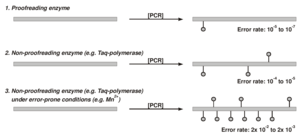Random Mutagenesis by Error-Prone PCR
| Cat. No. | Amount | Price (EUR) | Buy / Note |
|---|---|---|---|
| PP-102 | 15 reactions | 249,10 | Add to Basket/Quote Add to Notepad |

For general laboratory use.
Shipping: shipped on gel packs
Storage Conditions: store at -20 °C
avoid freeze/thaw cycles
Shelf Life: 12 months
Description:
JBS Mutagenesis Series
Within three billion years of evolution, nature has produced a plethora of proteins simply by repeated cycles of random mutagenesis followed by in vivo selection for superior function of the encoded proteins. This example of natural evolution has guided researchers within the last two decades to develop strategies for in vitro permutation of proteins.
Among the variety of strategies applied, three major powerful techniques have emerged.
Random Mutagenesis by dNTP Analogs
This method is based on the incorporation of mutagenic dNTP analogs, such as 8-oxo-dGTP and dPTP, into an amplified DNA fragment by PCR. The mutagenic dNTPs are eliminated by a second PCR step in the presence of the four natural dNTPs only, resulting in a rate of mutagenesis of up to 20%.
→ JBS dNTP-Mutagenesis Kit #PP-101
Random Mutagenesis by Error-Prone PCR
Developed by Caldwell & Joyce (1992) this method introduces mutations in the gene of interest using a PCR reaction under conditions that induce an increased error-rate of the DNA-polymerase. The rate of mutagenesis achieved by error-prone PCR is in the range of 0.6-2.0%.
→ JBS Error-Prone Kit #PP-102
Random Mutagenesis by DNA Shuffling
Developed by Stemmer (1994) DNA shuffling generates libraries by random fragmentation of one gene or a pool of related genes, followed by the reassembly of the fragments in a self-priming PCR reaction. This method allows the recombination of sequences from different, related genes. The overall rate of mutagenesis is approx. 0.7%.
→ JBS DNA-Shuffling Kit #PP-103
Jena Bioscience now offers all components necessary for each of these techniques 'ready-to-go' in a separate kit, accompanied by a streamlined documentation that maximizes success.
Content:
Taq Polymerase (red cap)
5 units/μl, 20 μl
10x Reaction Buffer (blue cap)
10x concentration, 100 μl
10x Error-prone Solution (yellow cap)
10x concentration, 100 μl
dNTP Error-prone Mix (white cap)
unbalanced dNTP ratio (dATP, dCTP, dGTP, dTTP), 40 μl
PCR-grade Water (white cap)
1 ml
Random Mutagenesis by Error-Prone PCR
The standard DNA polymerases used in conventional PCR reactions display error rates that are usually not suitable for directed mutagenesis experiments. For example, proofreading enzymes such as Pfu exhibit error rates in the range from 10-6 to 10-7 whereas non-proofreading enzymes like Taq Polymerase show error rates in the range from 10-4 to 10-5. This rate however, can be significantly enhanced by modifying the following parameters of a PCR-reaction:
Recommended assay preparation
Tab. 1: Amounts of components for error-prone PCR conditions (50 μl PCR assay)
| Component | Amount | Final conc. | Cap |
| 10x Reaction Buffer | 5 μl | 1x | blue |
| dNTP Error-prone Mix | 2 μl | unbalanced ratio | white |
| Primers | 20-100 pmol | ||
| Template | 3-100 fmol / 2 - 50 ng | ||
| Taq Polymerase | 0.4-1 μl | 2-5 units | red |
| PCR-grade Water | Fill up to 45 μl | white | |
| 10x Error-prone Solution | 5 μl | 1x | yellow |
| Denaturation | 94°C | 30 sec |
| Annealing1) | approx. 45-68°C | 30 sec |
| Extension2) | 72°C | 1 min |
For optimal specificity and amplification an individual optimization of the recommended parameters may be necessary for each new template DNA and/or primer pair.
BIOZ Product Citations:
Selected References:
Kim et al. (2001) Improvement of tagatose conversion rate by genetic evolution of thermostable galactose isomerase. Biotechnol. Appl. Biochem. 34:99.
Daugherty et al. (2000) Quantitative analysis of the effect of the mutation frequency on the affinity maturation of single chain Fv antibodies. PNAS 97:2029.
Wan et al. (1998) In vitro evolution of horse heart myoglobin to increase peroxidase activity. Proc. Natl. Acad. Sci. USA 95:12825.
Cline et al. (1996) PCR fidelity of Pfu DNA polymerase and other thermostable DNA polymerases. Nucleic Acids Res. 24:3546.
Vartanian et al. (1996) Hypermutagenic PCR involving all four transitions and a sizeable proportion of transversions. Nucleic Acids Res. 24:2627.
Cadwell et al. (1992) Randomization of genes by PCR mutagenesis. PCR Meth. Appl. 2:28.
Kunkel (1992) DNA replication fidelity. J. Biol. Chem. 287:18251.